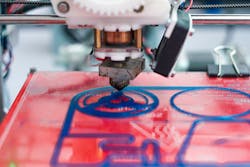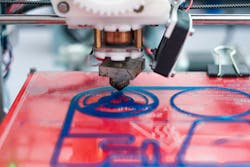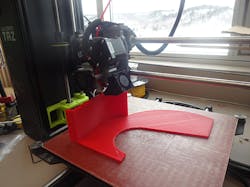The 3D printing community can be roughly divided into two groups: the high technology and the accessible technology sectors. Machine designers have embraced the high technology side for their work, but it may be time to take another hard look at the low-cost accessible technology side for the benefits such 3D printers can bring to the workplace.
High Technology of 3D Printing
The high technology sector of 3D printing is nearly homogeneously professionals, who normally refer to 3D printing as “additive manufacturing.” The high technology sector is made up of large industrial firms, major research universities, and government labs using high-end high-quality 3D printers (normally for exotic super alloys like Inconel) that cost more than half a million dollars a printer. The high-technology areas of 3D printing have started in rapid prototyping, but have been growing strongly into a variety of applications to make final products. For example, additive manufacturing is making inroads into areas such as aerospace manufacturing (see GE's latest push in the area).
Accessible Technology of 3D Printing
The accessible technology sector of 3D printing, on the other hand, comes from the RepRap community, whose goal was to create a self-replicating rapid prototyper—a 3D printer that could print itself. The project is remarkably successful having attracted both professional and amateur engineering talent from around the globe. They have pushed the price of a DIY 3D printer well under $500, with capabilities surpassing those of the best proprietary FDM 3D printers from a few years ago. Early RepRaps were only for the most dedicated and skilled hardware hackers. The early machine designs were poor, complicated, and difficult to assemble, calibrate, use, and maintain. The software was buggy and the prints were notoriously of poor quality. Worse, the reliability was so erratic that designers often had to babysit their prints, which were painfully slow (e.g,. they might last from a few hours to a few days). Despite this, they had a lot of promise.
Now, all of this has changed. The machines are now solid, reliable, and easy to use. As the costs have dropped, the quality has improved. I do most of my 3D printing using these accessible technology 3D printers at night and now rarely even bother to watch the first layer, let alone the entire print.
Open-Source Advantage
The RepRap is an open-source hardware project, which means that over the last decade or so, hundreds of innovators have been improving RepRap technology. Machine designers in general have the skills to easily build a RepRap, but they also have the option to buy a kit or a fully assembled 3D printer. The open sourcing of the RepRap has led to dozens of 3D printer companies that used the RepRap designs as a foundation to jump start their own products.
The competition among desktop 3D printers has been fierce, with even major additive manufacturing companies having difficulty establishing themselves in this new growing market. Remarkably, the open-source 3D printers now dominate the "prosumer" or desktop-level 3D printing market. Thus, companies that have stuck with the open-source philosophy enjoy the benefits of a free global engineering base that rapidly innovates on their products as part of the historic RepRap community. For example, the open-source Lulzbot TAZ is manufactured by Aleph Objects by a large bank of other TAZ 3-D printers themselves, thus even the commercial 3D printer follows a direct RepRap tradition. The TAZ won the best overall machine in the Digital Fabrication Shootout sponsored by Maker Media. This is remarkable because it beat all of the proprietary desktop 3D printers analyzed in 2015. The best value determined by the same contest was also an open-source 3-D printer: the Rostock Max (manufactured by SeeMeCNC). This machine looks radically different even though it 3D prints using the same technique because it is based off of the open-source deltabot style of RepRap. The results were similar last year. The top two spots went to open-source 3-D printers again: Prusa i3 MK2 from Prusa Research (a company started by one of the core members of the RepRap team) and the Lulzbot TAZ again.
A Second Look at the Accessible Technology 3-D Printers for Machine Designers
In general, the accessible technology of 3D printing now enjoys much greater reliability, automated bed leveling, and greater resolution than the printers of yesteryear. In addition, a number of these accessible technology companies have started to infiltrate the manufacturing areas previously reserved for the high technology sector. For example, re:3D offers a range of giant multi-head fused filament fabrication (FFF) style “gigabot” 3D printers that range from about $11,000 for 23.2 × 24 × 24 in. up to about $16,500 for 23.2 × 24 × 24 in. These are big printers that are meant to print big fully functional parts from a range of thermoplastic materials like nylon. They are also all open-source following the RepRap tradition.
However, even the desktop 3D printers are growing up. For example, the latest Lulzbot TAZ ($2,500 for 11 in. × 11 in. × 9.8 in.) recently came out with a new extruder called the “MOARstruder,” which sharply diverges from the longstanding trend in desktop 3D printing. In order to obtain high details and small features, 3D printer nozzle size has been dropping to complement a typical RepRap's 100 micron positional accuracy and z-step height minimum for reliable printing of many thermopolymers. The MOARstruder has a 1.2 mm diameter (as compared to a typical 0.3 mm diameter) along with an extra-long heater block and dual print cooling fans. This allows much higher output and thus much faster printing speeds. It enables the 3D printer to dump up to 100 grams (0.22 lbs) per hour, which can help machine designers with both faster rapid prototyping as well as full production of some products. For example, see the figure at left of a belt cover component printing from a MOARstruder for a shredding machine.
Actually using a desktop 3D printer to manufacture usable parts is possible, because the nozzle size improves the part strength. This result occurs because when we think we are 3D printing a solid there are actually microscopic triangle-shaped holes in between each line as the part is printed. By printing thicker lines, there are less holes per unit length and a greater interlayer adhesion. Not every 3D print needs ultrafine resolution. In many cases, for an engineer in particular, speed and strength are more valuable.
Thus, a modern machine designer now has the option to rapid prototype at their desk reasonably large parts at a time scale that fits in with work. For example, you can print a design over lunch, over a meeting, or for big prints—overnight. The costs of the tools are low enough that they are accessible to most businesses and even for those designing machines at home. It is time machine designers took a look at how desktop rapid prototyping might help them accelerate innovation in their own work.
References:
- Wittbrodt, B., & Pearce, J. M. (2015). The Effects of PLA Color on Material Properties of 3-D Printed Components. Additive Manufacturing. 8, 110–116 (2015). open access
- Freely licensed development files for the MOARstruder: http://devel.lulzbot.com/TAZ/accessories/opah/
Professor Joshua M. Pearce received his Ph.D. in Materials Engineering from the Pennsylvania State University. He is currently cross-appointed in the Department of Materials Science & Engineering and in the Department of Electrical & Computer Engineering at the Michigan Technological University where he runs the MichiganTech Open Sustainability Technology (MOST) Research Group.



